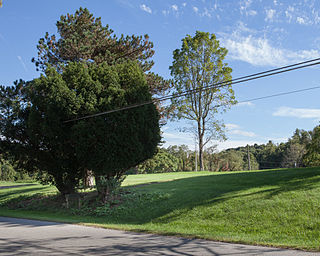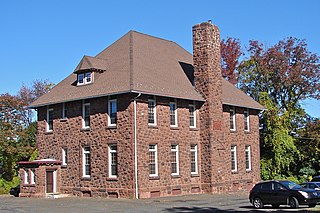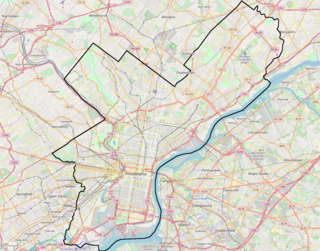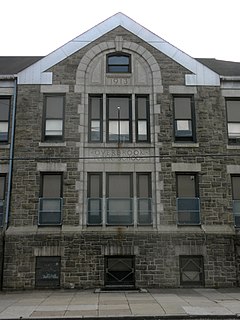
Harrison House was a historic building in Centerville, Pennsylvania. It was built c. 1845 as a Post Colonial Greek Revival house, and later updated to a High Victorian Italianate style. The five-bay 2 1⁄2-story structure with a two-story bay window unit with a turret roof and a four-story tower was unusual for the Washington County, Pennsylvania area.

Sinking Springs Farms is a historic farm and national historic district located at Manchester Township in York County, Pennsylvania. The district includes 32 contributing buildings, 2 contributing sites, and 17 contributing structures. The district includes the Manor House Demesne, four farmsteads, and a Radio Broadcast Complex. The manor house dates to 1900, and is a 2 1⁄2-story, Colonial Revival-style dwelling modified in 1936–1941. Farmstead #1 includes the earliest buildings, dated to about 1841. Farmstead #2 includes a Shingle Style dwelling designed by architect John A. Dempwolf and built about 1893. Farmstead #3 has a 3 1⁄2-story, banked Pennsylvania German dwelling built about 1845. Farmstead #4 has a 3 1⁄2-story, banked Georgian-plan dwelling built about 1845. The Radio Broadcast Complex includes a 2 1⁄2-story, brick Colonial Revival-style office building and four radio towers, and used as a radio station from the 1940s until 1990.

Corker Hill is a historic home and farm complex located at Greene Township in Franklin County, Pennsylvania. The manor house was built between 1810 and 1820, and is a two-story, seven bay, brick dwelling on a limestone foundation in the Federal style. The facade was modified about 1905, to add Colonial Revival style elements, such as a cupola and wraparound porch. Also on the property are the contributing large stone and frame Pennsylvania bank barn, stone vaulted root cellar, frame shed / chicken coop, frame carriage house / garage, small stone furnace building, wagon shed / corn crib, and frame tenant house.

Colver-Rogers Farmstead, also known as the Norval P. Rogers House, is a historic home located at Morgan Township in Greene County, Pennsylvania. The original section was built in 1830, and is a two-story, stone dwelling, with a two-story stone kitchen wing, in a vernacular Greek Revival-style. The house was modified about 1906, with the addition of a gambrel roof and rambling porch with Colonial Revival-style design elements. Also on the property is a bank barn and large wash house.

Bala Cynwyd Junior High School Complex, is a historic school complex in Bala Cynwyd, Lower Merion Township, Montgomery County, Pennsylvania. The complex includes the Bala Cynwyd Middle School, the Cynwyd Elementary School, as well as the former Lower Merion Academy. The elementary school and middle schools are part of the Lower Merion School District. The Lower Merion Academy / Lower Merion Benevolent School building was built in 1812, and is a 3 1⁄2-story, five-bay, stuccoed stone building with cupola in the Federal style. It was renovated in 1938, in the Colonial Revival style. The Cynwyd Elementary School building was built in 1914, with a rear addition built in 1920. It is a 2 1⁄2-story, Classical Revival style building that features white terra cotta trim and a central entrance with Ionic order columns. The Bala Cynwyd Middle School building was built in 1938, and is a long, flat, two-story brick building in the modern style. A classroom wing was added in 1963. The buildings were renovated and some additions built in 1999.

Alexander K. McClure School is a historic elementary school located in the Hunting Park neighborhood of Philadelphia, Pennsylvania. It is part of the School District of Philadelphia. The building was designed by Henry deCourcy Richards and built in 1910–1911. It is a three-story, five bay, brick building with a raised basement in the Colonial Revival-style. It features a three-story, rounded arched opening above the entrance, stone trim, and a rounded parapet. An addition was built in 1967. The school was named for journalist and politician Alexander Kelly McClure.

James Logan Elementary School is a historic elementary school building in the Logan neighborhood of Philadelphia, Pennsylvania. It is part of the School District of Philadelphia. The building was designed by Irwin T. Catharine and built in 1923–1924. It is a three-story, nine-bay, "U"-shaped brick building with a raised basement in the Colonial Revival-style. It features a central entrance pavilion, round arched surrounds, and a brick parapet.

Politz Hebrew Academy, formerly known as William C. Jacobs School and Fayette School, is a historic school located in the Bustleton neighborhood of Philadelphia, Pennsylvania. The building consists of an original section designed by Samuel Sloan in 1855, and the main building built in 1915. The original building is a two-story, stone building sheathed in stucco. The 1915 building is a 2 1⁄2-story, three-bay, rectangular brick building in the Colonial Revival style. It features a hipped roof and gable dormers.

William W. Axe School is a historic school building located in the Frankford neighborhood of Philadelphia, Pennsylvania. It was designed by Lloyd Titus and built in 1903–1904. It is a two-story, three-bay, stone building on a raised basement in the Colonial Revival style. It has a one-story, rear brick addition. It features stone lintels and sashes and a projecting center section with gable.

John Marshall Elementary School is a historic elementary school located in the Frankford neighborhood of Philadelphia, Pennsylvania. It is part of the School District of Philadelphia. The building was designed by Henry deCourcy Richards and built in 1909–1910. It is a three-story, five-bay by three-bay, brick building on a raised basement in the Colonial Revival style. It has a three-story, rear brick addition built in 1922. It features a pedimented cornice, brick parapet, projecting central section, and a two-story arched opening above the main entrance. The school was named for Chief Justice John Marshall.

Cedar Grove Christian Academy is a private Christian school located in the Lawndale neighborhood of Philadelphia, Pennsylvania. It is located in the former Lawndale School building. The school was built in 1903–1904, and is a two-story, three-bay, stone-faced brick building in the Colonial Revival style. Two two-story wings designed by Irwin T. Catharine were added in the 1920s. It features heavy stone sills and lintels and a crenellated parapet.

Watson Comly School, also known as Somerton Masonic Hall, is a historic school building located in the Somerton neighborhood of Philadelphia, Pennsylvania.

Mary Disston School is a historic school building located in the Tacony neighborhood of Philadelphia, Pennsylvania. It was built in 1900–1901, and is a two-story, three-bay, "U"-shaped stone building in the Colonial Revival style. A rear addition was built in 1967. It features a recessed central entrance with columnaded porch, arched openings, and a balcony; a central Palladian window; and hipped roof.

The Academy for the Middle Years (AMY) Northwest Middle School, formerly the William Levering School, is a historic middle school located in the Roxborough neighborhood of Philadelphia, Pennsylvania. It is part of the School District of Philadelphia.

Charles W. Henry School is a historic school located at 601 Carpenter Lane in the Mount Airy neighborhood of Philadelphia, Pennsylvania. It is part of the School District of Philadelphia. The building was designed by Henry deCourcy Richards and built by Cramp & Co. in 1906–1908. It is a two-story, 20 bay, red brick building in the Colonial Revival-style. Additions were built in 1949–1950 and 1968. It features arched entryways and limestone trim. It was the scene of a bombing during its construction in 1906.

Thomas Meehan School is a historic former school building located in the Germantown neighborhood of Philadelphia, Pennsylvania. It was built in 1901–1902, and is a two-story, five bay, stone building in the Colonial Revival-style. It features a portico with Doric order columns, arched openings, and a modillioned cornice. It was used for industrial purposes in the mid-20th century, and now is home to the Pentecostal Faith Assembly Church.

Charles Y. Audenried Junior High School was a historic school building located in the Grays Ferry neighborhood of Philadelphia, Pennsylvania. It was designed by Irwin T. Catharine and built in 1930-1931. It was a three-story, 15 bay, brick building on a raised basement in the Colonial Revival-style. It featured two projecting entrances with stone surrounds, a central entrance with four Doric order columns, projecting brick pilasters, and a brick parapet. The listed building has been demolished and replaced with the modern Universal Audenried Charter High School.

Grays Road Recreation Center is a historic recreation center located in the Grays Ferry neighborhood of Philadelphia, Pennsylvania. It was designed by John T. Windrim and built in 1926–1927. It is a 2 1⁄2-story, five-bay by nine-bay, red-brick building on in the Colonial Revival style. It has a gable roof with dormers, centrally placed arched entryway with stone surround, and two internal brick chimneys. The interior features a two-story auditorium, measuring 50 feet by 30 feet. The building was funded by the Richard Smith Family Trust.

Thomas Dunlap School is a historic former school building located in the Haddington neighborhood of Philadelphia, Pennsylvania. It was built in 1906, and is a three-story, nine bay by two bay, ashlar stone building in the Colonial Revival-style. It features a projecting, center cross gable bay, paired pilasters flanking the main entrance, and a modillioned copper cornice.

Overbrook Elementary School is a historic elementary school in the Overbrook neighborhood of Philadelphia, Pennsylvania. It is part of the School District of Philadelphia. The building was built in 1905–1907, and is a two-story, nine-bay brick building faced with granite in the Colonial Revival-style. It sits on a raised basement. An eight-bay addition designed by Henry deCourcy Richards was built in 1913–1914. It features a slightly projecting front gable.
























